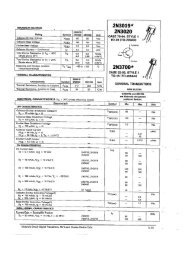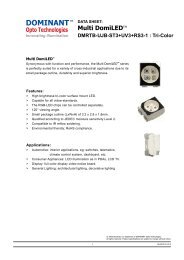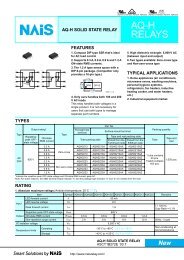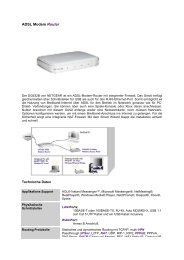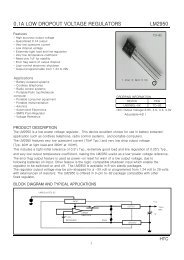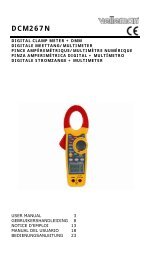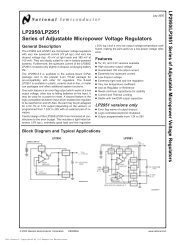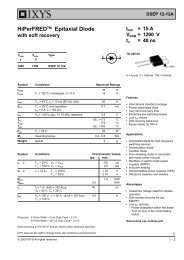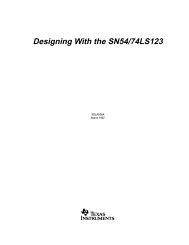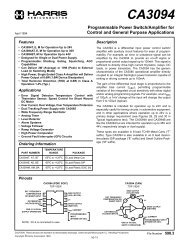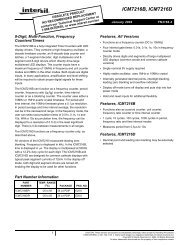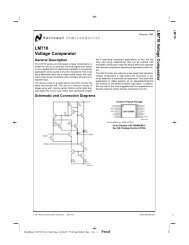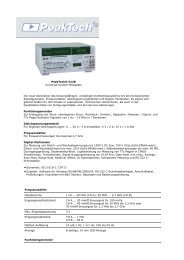LT3080 - Adjustable 1.1A Single Resistor Low Dropout Regulator
LT3080 - Adjustable 1.1A Single Resistor Low Dropout Regulator
LT3080 - Adjustable 1.1A Single Resistor Low Dropout Regulator
You also want an ePaper? Increase the reach of your titles
YUMPU automatically turns print PDFs into web optimized ePapers that Google loves.
<strong>LT3080</strong><br />
APPLICATIO S I FOR ATIO<br />
from the error amplifi er must be considered, and the gain<br />
created by using a resistor divider cannot be forgotten.<br />
Traditional low noise regulators bring the voltage reference<br />
out to an external pin (usually through a large value<br />
resistor) to allow for bypassing and noise reduction of<br />
reference noise. The <strong>LT3080</strong> does not use a traditional<br />
voltage reference like other linear regulators, but instead<br />
uses a reference current. That current operates with typical<br />
noise current levels of 3.2pA/√⎯Hz (1nARMS over the<br />
10Hz to 100kHz bandwidth). The voltage noise of this is<br />
equal to the noise current multiplied by the resistor value.<br />
The resistor generates spot noise equal to √⎯4⎯k⎯T⎯R (k =<br />
Boltzmann’s constant, 1.38 • 10-23 J/°K, and T is absolute<br />
temperature) which is RMS summed with the reference<br />
current noise. To lower reference noise, the voltage setting<br />
resistor may be bypassed with a capacitor, though<br />
this causes start-up time to increase as a factor of the RC<br />
time constant.<br />
The <strong>LT3080</strong> uses a unity-gain follower from the SET pin<br />
to drive the output, and there is no requirement to use<br />
a resistor to set the output voltage. Use a high accuracy<br />
voltage reference placed at the SET pin to remove the errors<br />
in output voltage due to reference current tolerance<br />
and resistor tolerance. Active driving of the SET pin is<br />
acceptable; the limitations are the creativity and ingenuity<br />
of the circuit designer.<br />
One problem that a normal linear regulator sees with reference<br />
voltage noise is that noise is gained up along with the<br />
output when using a resistor divider to operate at levels<br />
higher than the normal reference voltage. With the <strong>LT3080</strong>,<br />
the unity-gain follower presents no gain whatsoever from<br />
the SET pin to the output, so noise fi gures do not increase<br />
accordingly. Error amplifi er noise is typically 125nV/√⎯Hz<br />
(40μVRMS over the 10Hz to 100kHz bandwidth); this is<br />
another factor that is RMS summed in to give a fi nal noise<br />
fi gure for the regulator.<br />
Curves in the Typical Performance Characteristics show<br />
noise spectral density and peak-to-peak noise characteristics<br />
for both the reference current and error amplifi er<br />
over the 10Hz to 100kHz bandwidth.<br />
Overload Recovery<br />
Like many IC power regulators, the <strong>LT3080</strong> has safe operating<br />
area (SOA) protection. The SOA protection decreases<br />
12<br />
U W U U<br />
current limit as the input-to-output voltage increases and<br />
keeps the power dissipation at safe levels for all values<br />
of input-to-output voltage. The <strong>LT3080</strong> provides some<br />
output current at all values of input-to-output voltage up<br />
to the device breakdown. See the Current Limit curve in<br />
the Typical Performance Characteristics.<br />
When power is fi rst turned on, the input voltage rises and<br />
the output follows the input, allowing the regulator to start<br />
into very heavy loads. During start-up, as the input voltage<br />
is rising, the input-to-output voltage differential is small,<br />
allowing the regulator to supply large output currents.<br />
With a high input voltage, a problem can occur wherein<br />
removal of an output short will not allow the output voltage<br />
to recover. Other regulators, such as the LT1085 and<br />
LT1764A, also exhibit this phenomenon so it is not unique<br />
to the <strong>LT3080</strong>.<br />
The problem occurs with a heavy output load when the<br />
input voltage is high and the output voltage is low. Common<br />
situations are immediately after the removal of a<br />
short circuit. The load line for such a load may intersect<br />
the output current curve at two points. If this happens,<br />
there are two stable operating points for the regulator.<br />
With this double intersection, the input power supply may<br />
need to be cycled down to zero and brought up again to<br />
make the output recover.<br />
Load Regulation<br />
Because the <strong>LT3080</strong> is a fl oating device (there is no ground<br />
pin on the part, all quiescent and drive current is delivered<br />
to the load), it is not possible to provide true remote load<br />
sensing. Load regulation will be limited by the resistance<br />
IN<br />
VCONTROL <strong>LT3080</strong><br />
+<br />
–<br />
SET RSET<br />
OUT<br />
PARASITIC<br />
RESISTANCE<br />
3080 F07<br />
Figure 7. Connections for Best Load Regulation<br />
R P<br />
R P<br />
RP<br />
LOAD<br />
3080f



